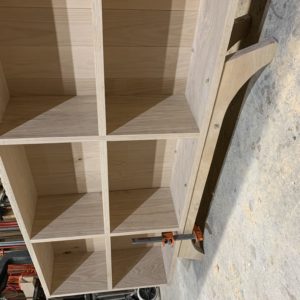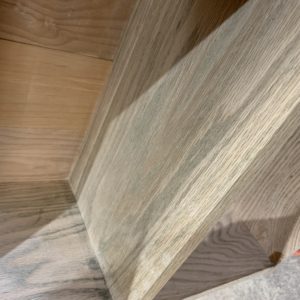Hello from deep in the ‘quar!
I have a question about danish soap turning green in white oak. I’ve been using soap finish for about a year now, but mostly in Adler and Ash pieces. It’s always gone perfectly. Now, on this white oak, the pores deep pores in the wood are collecting the soap and turning green. I was able to get it all out with a wire brush and am back to a clean surface. I then did a test piece of scrap with the following preparations (it still turned green):
sanded, vacuumed, blew out with air compressor, and finally wiped with DNA.
I applied with a white rag, no dye.
Any ideas on why this is happening?
One last question! My client loves the Hans Wenger look. If soap doesn’t work out, what ideas might you have for a natural finish? I’m thinking beeswax but open to other ideas.
I appreciate you all and hope you stay well.
jon
(attached is two pictures of the unfinished whole piece, and then one of the mean green finish)


















Replies
Hey, very interesting you had good results on white ash but not white oak. Do you know the ingredients of the soap finish? There could be some metal ion/ salt additive reacting to the oak... no real idea though. As an alternative, a treatment I like for a whitewashed, danish soap like appearance is an initial lye wash finished with shop made beeswax + mineral oil. I shoot for 1:2 beeswax to mineral oil, but you can't screw it up. Ends up with a beautiful, matte lustre and is soft like soap finish. For a natural lye wash, check out Woca. Seems to work. Good luck!
To Op, I had the same problem with oak and alder. It was turning them green and gray.
What type of soap were you using? I was using a shredded bar of Kirk's Castile soap. I finally have been able to get my hands on some soap flakes and I am going to try again and see if I get different results. I have a hypothesis that it could also be something in the water that could be causing the issue. The water here is incredibility hard. I will be trying again with distilled water and see if there different results.
The current Wegner offerings are soap, oil, and laquer. I believe that many of the original chairs, at least the ones that ended up in the USA, came with a conversion varnish. If soap or a soap substitute do not work out you have a few other "correct" options.
Osmo oil in natural (raw) either with or without a first coat of their white oil looks promising. However, they are way to pricey for me to be experimenting with right now. I need to get a few things made to get my money out of those cans. Caleb James finished a chair recently finished with Osmo (I am unsure of the type). It looked fantastic with that finish.
If you buy the maintenance kit for the current chairs it comes with Guardian white pigmented oil. I have not been able to find a US distributor to test it out.
I've been experimenting with water-based poly and it seems to be in camp of looking right if you can get the sheen correct and use a minimal amount of coats. It seems too look like plastic real quick, but then again, nearly all film finishes look like plastic to me. I am likely not the best judge for that. It does not look like soap though.
To Op, I had the same problem with oak and alder. It was turning them green and gray.
What type of soap were you using? I was using a shredded bar of Kirk's Castile soap. I finally have been able to get my hands on some soap flakes and I am going to try again and see if I get different results. I have a hypothesis that it could also be something in the water that could be causing the issue. The water here is incredibility hard. I will be trying again with distilled water and see if there different results.
The current Wegner offerings are soap, oil, and laquer. I believe that many of the original chairs, at least the ones that ended up in the USA, came with a conversion varnish. If soap or a soap substitute do not work out you have a few other "correct" options.
Osmo oil in natural (raw) either with or without a first coat of their white oil looks promising. However, they are way to pricey for me to be experimenting with right now. I need to get a few things made to get my money out of those cans. Caleb James finished a chair recently finished with Osmo (I am unsure of the type). It looked fantastic with that finish.
If you buy the maintenance kit for the current chairs it comes with Guardian white pigmented oil. I have not been able to find a US distributor to test it out.
I've been experimenting with water-based poly and it seems to be in camp of looking right if you can get the sheen and a minimal amount of coats. It seems too look like plastic real quick, but then again, nearly all film finishes look like plastic to me. I am likely not the best judge for that.
Tropijoel, that is a good suggestion that I will have to try. I used regular paste wax on raw wood and it was close, but it was too dark. Soap seems to go a touch lighter than raw. The wax, went just a touch darker, but not so much you would notice if you did not have a raw piece of wood to compare it too. Coating it with lye to lighten it first is a good idea.
“[Deleted]”
Just a follow up. Using distilled water seemed to have helped with the staining problem I was having.
I have the same issue using soap flakes on an ash stool I have made. Funnily enough though, I didnt get the issue when I tried on two small test pieces. Can you tell me what process you followed with the distilled water? Did you warm it to mix the soap flakes? Did you just buy distilled water or make? Thanks
I do not remember the exact ratio of soap to water I used. I purchased distilled water, boiled it, then mixed the soap and water. I boiled more water than I needed as I was experimenting with different ratios.
This forum post is now archived. Commenting has been disabled